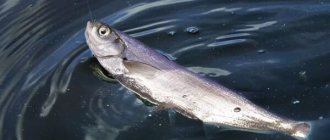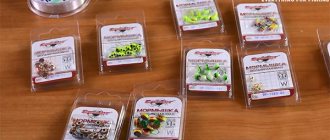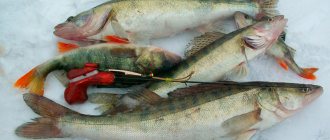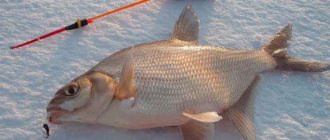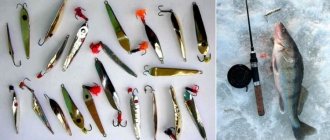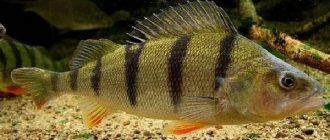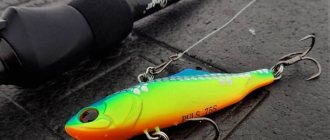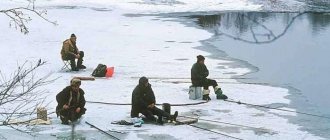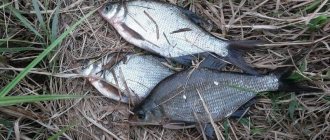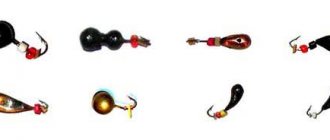Features of catching sabrefish from ice
This silver saberfish is a desirable catch for many anglers. Chekhon, especially large ones, are stubborn in resistance and reckless in attacks on a hook or spoon. In addition to sporting interest, fishermen also have selfish interest. Chekhon is a very tasty fish, especially when dried.
Often, fishermen gather with the whole family for autumn saberfish, since it is at this time that sabrefish are the most tender and fatty, intensively preparing for winter and therefore grabbing everything that moves. This time is also called the autumn move. Therefore, during the period of first ice, its activity still continues, and the fish itself is fatty in autumn.
During the period of first ice, sabrefish mostly stay at depths of 3-5 meters on the border of a large and deep hole. This is a typically schooling fish and does not change its habits in summer and winter. Therefore, for effective fishing for sabrefish in winter, two main factors must coincide - a long thaw with equal atmospheric pressure and a parking area for a large flock of sabrefish. If the first factor is completely objective and the fisherman cannot influence it, then local residents always have information about the presence of a school of fish in a reservoir. It is best to look for paths to the soul of a local resident, and what local-style diplomacy will look like is a personal matter.
Closer to spring, sabrefish begin to bite more actively, often being caught along with bleak in the surface layers of the water. In general, sabrefish almost always stay in the water column and near the surface. But in winter, its mooring sites are at the bottom level. In the spring, sabrefish increasingly come to the surface and its flocks begin to move to the mouths of rivers, along which sabrefish will soon rise to spawn. This is where pre-spawning ice fishing takes place.
Inhabited in the middle reaches of the Volga, saberfish are still more numerous and active in the lower reaches of the big river. Like all cyprinids, this is a heat-loving fish and the temperature regime of the Volga delta is more favorable for it.
Useful tips for increasing your catch:
• When fishing with several gears at the same time, bright red balls are attached to the tips of the nods - against the background of white snow, the slightest movements of the alarm will be noticeable. • Quite often, instead of a weight, a “Uralka” is attached to the fishing line - a heavy jig that can hold the tackle in the current. This installation is convenient when the gear is frequently twitched. At the same time, the bait also clings to it. According to anglers, it is with this jig that large kilogram specimens bite. • The sabrefish bites not only in the light, but also in the dark - often night fishing can be much more successful than daytime fishing. • Hooks and jigs can be decorated with bunches of multi-colored threads or hairs that imitate an insect. • Catching sabrefish in winter with a spoon is very inconvenient - you need light baits designed for perch, which are easily carried away by the current. • The lips of the saber fish are weak and break easily, so the hooking must be careful and smooth.
Catching sabrefish in winter is not as simple as it might seem at first glance. Not only the wrong choice of place, but also unnecessary noise can leave a fisherman without a catch. Nevertheless, ice fishing for saberfish has a lot of fans due to its rather sporting nature. Although the gear does not require the constant participation of the fisherman, it is very difficult to notice the slightest bites of this fish. But if you approach fishing responsibly, the reward can be several dozen sabrefish, which have fatty and tender meat, especially revered when dried.
Catching sabrefish in winter using edible rubber
Just recently, it was difficult to imagine that sabrefish could be caught with some kind of rubber. Typically, the traditional gear for catching sabrefish in the summer has always been a donka with a rubber shock absorber and a spinning rod for large sabrefish. Despite its rather peaceful appearance, sabrefish of decent size eat fry quite successfully and with appetite. That’s why it takes different spinning baits, and the smaller ones prefer worms on shiny nickel-plated hooks. And here a predatory but secretive nature is visible... And if you consider that there are saber fish weighing up to a kilogram, then these are real predators.
Meanwhile, in catching sabrefish in winter, traditional gear was usually used: a winter fishing rod, various garlands and tyrants. With the advent of edible rubber, catching sabrefish from ice acquired completely new features. And in the first row of innovative lures are the so-called Hogy Hog. These strange creatures, the material for which was soft plastic, are unlike anything living that lives on planet Earth. And at the same time, they resemble some kind of monsters from horror films. Lots of legs, some kind of tails, claws. All this fluctuates under the pressure of water. Probably, for fish, the appearance of these baits is associated with some kind of insects or crustaceans living under water. The fish has no time to look at how many legs and tails the potential prey has, moving and smelling delicious. Grab it before someone else grabs it!.. All these moving active elements of Hoagie Hog baits often attract passive fish. Moreover, unlike silicone, these baits have a taste, which means that the fish only needs to pinch the bait once to feel it, this taste, and attack even after the first unsuccessful attempt. Therefore, on the second, third, fifth retrieve, the saberfish will still return and take the bait more reliably.
The effectiveness of Hogy Hog baits is explained by the fact that the smell and taste of the baits are long-lasting, since the baits are made of a material consisting of sixty percent of those same smells and tastes, that is, the bait does not just have a surface layer of flavor ingredients, but is almost entirely composed of them . In addition, Hoagy Hogs are coated with oil on the outside. This oil, of course, will be washed off during long fishing, giving a bright effect only at the beginning of fishing, but the smell and taste will still remain due to the properties of the bait material.
As you know, in winter fish prefer not sweet biscuit smells and tastes, but more high-calorie components, even if it is an imitation. The interest of cyprinids, including sabrefish, is sometimes aroused by such strange odors as the smell of red caviar, salmon, and fish in hemp. The above edible rubber baits most often have the smell and taste of crayfish and shrimp. This corresponds to the winter demands of the fish.
Lucky John produces these baits in sizes corresponding to the size of potential prey. For fishing for saberfish, Hogy Hog lures measuring 1.2 inches are most suitable. The same baits are used for catching perch. For fishing for larger predators - trout, pike perch, pike - there are baits with 1.6 inches.
Small jigs are used to deliver bait into the water column. But here we must take into account the peculiarity of Hoagie Hog baits, which can be called rather large baits. Therefore, the jig hook must be selected specifically for them, and these will most likely be hooks No. 13-11 of international numbering. Moreover, there may be a discrepancy between the size of the jig and the hook, where the latter will be disproportionately large. And this can be called the norm when using our bait.
The method of attaching a Hogy Hog to a hook is that the tip of the hook is inserted into the front part of the bait, which can be conventionally called the head, and removed from the pseudo-abdomen between the same conventional legs and claws.
The technique of fishing with a jig with edible rubber bait is quite varied. Somewhere it will be a slow lowering of the bait to the bottom with smooth swaying of the nod, which is reminiscent of the game of a jig when fishing for bream and roach. Then the jig's play mode is turned on, as when fishing for perch, that is, a quick upward rise with relatively frequent oscillations of the jig. Sometimes the grip follows at the very top of the drive, while pausing in this position. It is after a quick game and stopping the bait at the top point that sabrefish bites most often occur. Considering the tendency of sabrefish to the middle and upper layers of water, you need to fish higher from the bottom, raising the bait with each retrieve. This is usually how you search for the level in the water column where a flock of saberfish stands.
Fishing technique
- When the fish is active, you just lower the rig just above the bottom, adjust the nod, and tighten the line.
- For edible gum. Slowly lower the bait to the bottom, shaking the nod. Quick rise to the top with frequent oscillations of the jig. Stop at the top point, after active play, to bite sabrefish.
- Select in the morning the holes that were previously used. If there is no bite for an hour, change place. You can place several garlands in different holes by drilling them close to each other.
- As soon as the nod moves, smoothly hook. If you strike sharply, the fish may escape.
- Don't make unnecessary noise. There is a risk of scaring off the whole flock.
Garland tackle for catching saberfish in winter
This equipment, consisting of several jigs or hooks with bait, is sometimes called a “garland”, and sometimes called a “tyrant”, “herringbone”. This ingenious tackle, quite cumbersome and often tangled, was invented in order to quickly find that same golden level in the water column at which sabrefish are held on a given specific day and in a specific place.
And saberfish are famous for their inconstancy, sometimes adhering to the bottom layers of water, sometimes to the middle ones, and sometimes standing almost under the very ice. Obviously, such inconstancy is associated with the movement of bioplankton in the water column, and the fish simply fall and rise for their daily food. Probably, the atmospheric pressure on this day also affects it, to which any fish reacts sensitively, but carp react especially painfully.
As already mentioned, sabrefish perform best during long thaws, especially if the air temperature tends to be above zero. But even then it cannot be guaranteed that saber fish will be taken in the morning. You can sit in vain all morning, and the saber fish will suddenly start pecking in the afternoon, so much so that the box will fill up before your eyes. For better results, local Volga fishermen use several garland fishing rods at once, placing them in holes in places where schools of saberfish are found. The main thing is that in such places there are no dense concentrations of fishermen, then consider that fishing for saberfish is lost. Where many holes have been drilled and new holes are still being drilled, the saber fish will not stand for long, but, most likely, will move from its place and go looking for a calmer reach.
Unlike traditional winter fishing, where a regular balalaika-type fishing rod or a standard winter fishing rod with legs is used, fishing with a tyrant garland will require a more powerful rod. As we know, saber fish stays with the current even in winter. Therefore, a fairly thick fishing line with an undergrowth on which several jigs are tied will create an effort that can be critical for a regular fishing rod. There is a risk that the whip or other part of the fishing rod will break. Volga fishermen use fishing rods for side fishing or for trolling, equipping the fishing rod with a rather rigid metal nod, at the end of which a bright plastic or pressed foam ball is attached. Placed in several holes, such fishing rods are clearly visible and the bite does not go unnoticed, since the fisherman detects the red or orange balls on the nods even with peripheral vision, especially when they begin to nod hecticly from the sharp jerks of the active sabrefish. It is better to equip such rods with reels instead of a reel, since when changing holes it is necessary to reel in not only the main line, but also the undergrowth with baits. For such fishing, so-called “fillies” are also successfully used, made of pressed foam plastic, which stand reliably and steadily on the ice, and are not only a fishing rod, but at the same time a reel. The handle of the “filly” is precisely the reel for winding the fishing line.
But such gear is not always just fishing rods for stand-up fishing. From time to time, the angler lifts one of the fishing rods and begins to make slow pulls on himself, as in the summer when catching sabrefish on a donk with a rubber shock absorber. Chekhon is an exciting fish and often immediately responds to the movement of baits. It happens that a fishing rod was standing there without a single bite, but you just touched it, pulled the rig towards you, stopped it and pulled it again, and during a pause suddenly in your hand - knock-knock! Yes!.. Bite!
Typically, for equipment, a fishing line with a diameter of 0.17 mm is used as the main one, and for the leader, which is attached to the main fishing line using a fastener with a swivel, it is better to take a slightly thinner fishing line - 0.14 mm thick, and for leashes - 0.12 mm. Small light jigs are placed on the undergrowth or hooks with nickel or silver coating No. 15-13 of international numbering are tied. The hooks are placed on short leashes only 2-3 cm long. Longer leashes can completely tangle the tackle and will certainly begin to cling to the edges of the hole. You can alternate jigs and hooks. It wouldn’t hurt to equip the hooks with additional active elements like scarlet hairs or white cambrics.
If the current is quite strong, then at the end of the main line it is better to place a weight or a heavy jig, for example, “Uralka”. Often such a heavy jig catches a real sabrefish weighing up to a kilogram, but more often a jig with a sprat or a worm is attacked by pike perch and bershi.
In the spring, night fishing for saberfish is sometimes very successful. For such fishing, you need to have a spare additional undergrowth with luminous phosphorus jigs tied to it.
The most popular baits for sabrefish are traditional bloodworms and maggots. But sabrefish sometimes take better, either on ordinary white-yellow maggots or on painted red maggots. Therefore, you need to have both in stock. Sometimes an effective bait is a “sandwich” of bloodworms and maggots.
Garland for saberfish
A garland is a fishing line with a sinker, to which five leashes with hooks are attached. The number of leashes may be greater. The main thing is that they do not get confused causing inconvenience. The garland is attached to a spinning rod, which allows for long casting. Feeder fishing with a garland requires taking into account a number of factors:
- current intensity in a reservoir;
- weather features;
- weight of the feeder (up to 60 grams).
How to mount a garland - video:
Bait should be supplied to the fishing site regularly. To simplify fishing, use a 2-meter leash, and also equip the fishing rod with foam balls. The feeder should not be too heavy so that it sinks to the bottom gradually when casting. You should not compact the complementary food too much so that it is washed out in the water column easily and gradually. Crumbly porridge is used as bait, and maggots are used as bait.
The fishing technique is as follows. After a fishing spot has been chosen, the fishing point is fed by making 5 to 10 casts with a large-diameter feeder filled with bait. This allows you to feed the point faster. The next stage is casting gear with hooks and bait. Casting is not very convenient due to the long leashes, but you quickly get used to it.
Feeder tackle (garland) for catching saberfish - video:
Catching sabrefish on a winter fishing rod with a hook
Sometimes, catching sabrefish from the ice does not require any frills in the form of edible rubber baits and complex garland gear. When sabrefish are active and adventurous, and this happens most often during the first ice and in the spring, it can be caught well with the simplest fishing rod, which can be called a symbiosis of a summer float and a winter fishing rod. How can it be? Very simple. The upper part of the fishing rod is traditionally winter, that is, it is a fishing rod, for example, a “balalaika”, a rather soft lavsan nod and the main fishing line. The lower part is a diagram of a summer rig, where a lead sinker is attached above a small hook No. 15 at a distance of 10-12 cm. This type of gear works best in low currents. Here too, it is best to use a shiny hook, since saberfish respond best to an object that is somewhat similar to a tiny fry.
The main line used is not as thick as on the garland. It is enough to install a monofilament with a thickness of 0.12 mm, and a leash with a thickness of 0.1 mm. When fishing for medium-sized sabrefish, this thickness is quite enough.
The fishing technique has no tricks. The tackle is simply lowered into the upper layers of the water, where sabrefish are often caught together with bleak in the spring. No bait game required. A baited hook ripples the current. You just need to change the depth, because sometimes the primary task is to find the level in the water column where there is a school of silver fish.
Winter fishing rod based on the “float” principle
The simplest and often the most effective gear is a winter fishing rod, designed on the principle of summer float gear. Along with saberfish, bleak often bites well on it. The tackle is designed almost like a classic winter fishing rod, that is, a winter fishing rod with a stand for installation at the hole has a reel and a nod, but instead of a jig, the smallest hook is attached, and a sinker is attached above. Bloodworms and maggots, as well as Hoagie Hog, are attached to the hook. As spring approaches, there are more and more bites for maggots.
Groundbait and its components
You can catch saber without bait. However, for sabrefish fishing to be truly effective, it is better to use all available methods.
Feeding should be done in small portions, because the main goal of the fisherman is to keep the flock without saturating it. You should not use only sunflower cake or porridge for this purpose: in this case, only one small thing will fall on the hook. As a basis for bait, you can choose any basic compositions available in stores. When preparing the mixture, it is necessary to add to it the bait on which fishing is carried out, and what the saber fish bites best on - chopped worms or maggots.
Throwing bait in bulk is useless: the current will wash it away in a couple of minutes. As a container for the mixture, you can use a special jar made of perforated sheets, a mesh bag, or an old nylon stocking.
Winter fishing for sabrefish, or how to see the coveted fish on your hook
Winter fishing for sabrefish is a complex process, but at the same time quite interesting, since not everyone is able to get the coveted fish in the winter season.
The problem with catching sabrefish lies in the fact that sabrefish are quite inactive in winter and tend not to feed at all. With the onset of the low temperature inherent in winter, the saber fish goes into the pits , where it, in most cases, remains until the onset of spring. In this regard, there is no point in starting conversations regarding regular feeding of sabrefish. If an angler has an irresistible desire to catch the fish in question during the winter, he should know that the most successful search for fish will be rewarded in areas of bordering currents. More specifically, saberfish are more often found at river bends in winter.
Catching sabrefish using long-distance casting gear
The saberfish is a very cautious fish; the slightest noise can cause a deterioration or complete cessation of the bite, especially if fishing is carried out close to the shore or a floating vessel. Most often, sabrefish stay in remote areas of the reservoir, where it is possible to cast bait only if you use long-distance casting gear.
An excellent choice for fishing would be a match rod six meters long, which must be equipped with a light reel. The tackle is supplemented with a thin fishing line (cross-section 0.14-0.16 mm), the use of a leash is mandatory; fishing line with a cross-section of 0.02 mm is suitable for its manufacture. The load is determined depending on the carrying capacity of the float, which should not exceed 7 grams.
Note that the load is located depending on the depth at which it is desirable for the bait to be located. If it is important that the bait is on the surface, then the weight is placed literally under the float itself or a few centimeters from it. It is important to understand that the smaller the load and the greater the distance to it, the longer it will take the bait to lower to the point, and the greater the lowering arc will be, which has a positive effect on fishing.
When fishing using light equipment, sharp hooks should not be made at the moment the sabrefish bites - this can cause the line to break. The cast is made towards a promising place, but not to the point itself. The current carries the equipment to the place where the sabrefish are staying; as a rule, you don’t have to wait long for a bite.
